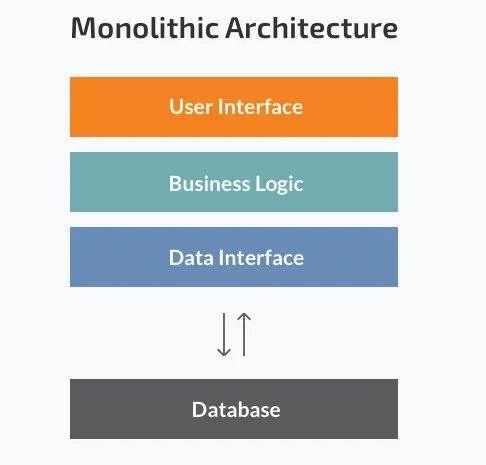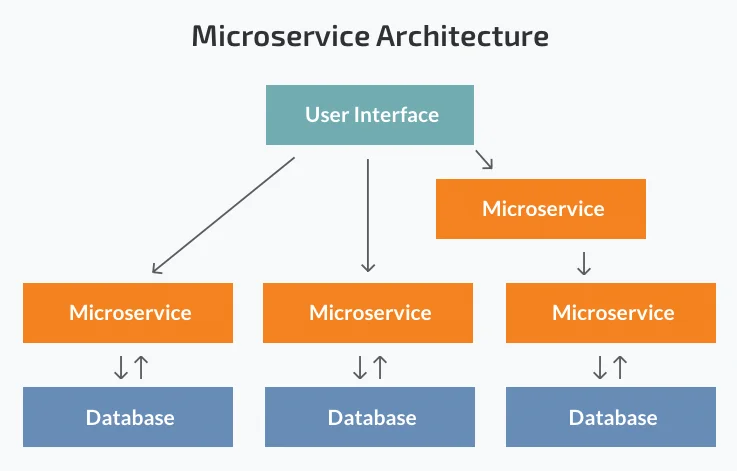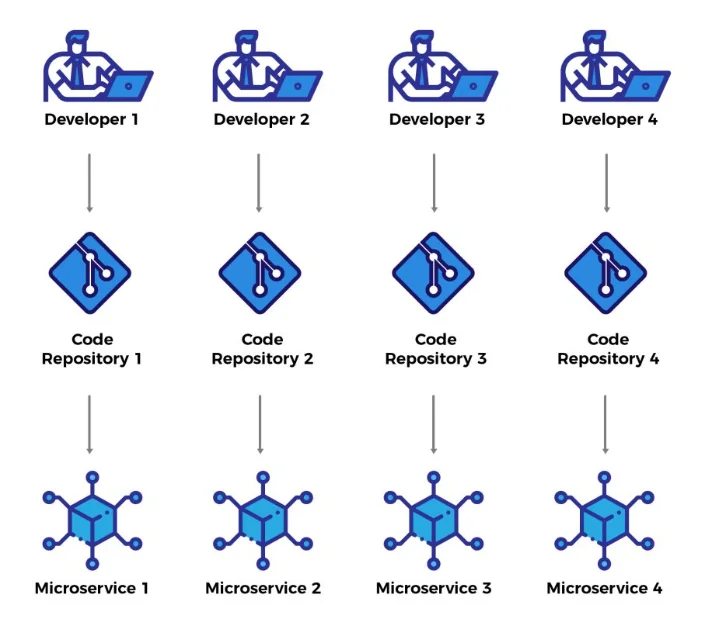Software development in the last decade has largely moved from a monolithic architecture to a microservices-based architecture. The adoption of cloud platforms accelerated that transition to microservices architecture.
But what does it really mean? Why did that happen, and which architecture is best for your development project? How does microservices architecture tie in with containers and cloud setups? We will cover all that and more in this blog.
Let’s start with the older architecture of the two – Monolithic architecture.
Monolithic Architecture
A monolithic architecture is where the entire application is developed as a singular large codebase. Each of the components of the codebase, like – the frontend, backend, and configuration files, are tightly coupled to each other.
Monolithic architecture was the go-to architecture strategy for any software development project about a decade ago. This kind of development is faster to develop and requires less planning.

Some of the common issues that happen with monolithic architecture is to do with challenges in scalability and the ability to adapt to changing requirements.
Let’s look at the advantages and disadvantages in some detail.
Advantages of monolithic architecture
- Faster development
Since all the components of a monolithic application lie in a singular codebase, a small development team can quickly develop and deploy the application. This approach is excellent for building prototypes and proof-of-concept.
The deployment process also involves a lesser number of dependencies. And hence it results in faster deployment times.
- Generally more secure
Lower the number of components, lesser number of loopholes in the system. In a monolithic architecture, security is typically handled in one place. This means there is no need to track vulnerabilities in hundreds of small components.
- Quicker to test
Monolithic systems have easier test workflows since the number of inputs and outputs is limited to a single system. With one code repository, it is easier to track testing workflows and debug the issues.
- Needs lesser specialized skills
With monolithic applications, the individual components within them are not directly accessible. This makes them less complicated to develop. For example, in a monolithic architecture, one cannot access the database module directly from external code. All code goes into the main codebase.
In applications where each component is a small application of its own, the development team needs to design each component with many more interaction scenarios in mind. This is much more complicated and often requires specialized skills.
Disadvantages of monolithic architecture
- Scalability issues
Since all components are tightly coupled in a monolithic architecture, the performance of the entire application becomes the lowest common denominator of the performance of all components.
The slowest component will become the bottleneck for the application, and it may require substantial rework to scale the application beyond a point.
- Increasing complexity
Over time, as more requirements are accommodated in a monolithic architecture, it soon becomes extremely complex to make changes.
Many of the interdependencies between components may not be as evident in the later phase of development. This increases the time and effort required to make the smallest of changes.
- High cost of technology change
Complexity of the codebase in monolithic architectures makes it extremely difficult for such applications to adopt newer, more efficient technologies. Any technology change would typically require massive changes and redesigns in most of the major components of the application.
This high cost makes monolithic application work with legacy technologies for a much longer period of time.
- Single point of failure
Since the components in a monolithic architecture are tightly coupled, a failure of one may cause the entire application to go down.
Interdependencies of these components make it impossible for monolithic applications to continue functioning while one component is down.
Microservices Architecture
In a microservices architecture, each component of the application is developed as an independent codebase. Every component in this architecture focuses on just one specific task. Each component will also have neatly defined input-output methods and can be deployed and scaled independently of the application it is a part of.
All components in the architecture interact with each other through what is called an API i.e., Application Programming Interface. Each such component is called a microservice.

Let us look at some of the advantages and disadvantages of a microservices-based architecture.
Advantages of microservices-based architecture
- Independent components
Each component in a microservices-based architecture is an independent service. The codebase is maintained separately, and the changes to it can be performed separately without impacting the rest of the components in the application.
- Flexible functionality
Since each of the functionalities is a separate component, it is much easier to add or remove functionalities from the application.
All the components are loosely coupled to easily detach and connect into a different workflow. The development of newer functionalities takes much lesser time than a monolithic application.
- Easy to scale
Each microservice can be independently scaled to handle greater traffic and requirements without affecting other components of the application. This makes scalability of the entire application less costly and more efficient.
Disadvantages of microservices-based architecture
- Requires specialized development skills
A microservices architecture has many moving pieces. This requires careful planning and design to create a stable application.
Each microservice is focused on one functionality and must be capable of reuse in other applications. This often requires a greater understanding of the functionality and the technologies that best work for the said requirements.
- Increased security threat
Each microservice must be separately secured. With more microservices, there will be more API vulnerabilities, and day-zero attack possibilities. Hence, a microservice-based architecture requires greater focus on the security threats.
Often an extensive security standards and protocols are set for all components in the architecture.
- Increased testing
More independent components means more vulnerabilities. That also mean greater scope of testing to make the application secure. This often increases the cost of development.
- Higher initial costs
Developing, managing and supporting numerous microservices increases the initial cost of the development. Although in the long term, the costs are often lesser than a monolithic architecture.
Microservices architecture is often more expensive for a prototype or proof-of-concept.
This begs the question, how do you decide which architecture to choose for a certain use case. Let’s discuss this in some detail.
When to choose which architecture
There are some factor that can help you determine the right architecture. Here are the important ones:
- Complexity of requirements
If you are trying to develop a prototype or a proof-of-concept, monolithic architecture will often be much faster and cheaper. Another usecase is when the requirements for the application are very simple and the application is only needed for a short while. In all these cases, a monolithic application is the way to go.
For anything complex and one that will expected to last a long time with frequent changes in the requirements, microservices-based architecture will pay off better in the long run.
- Time to market
Microservices-based application takes much longer to design and build. For systems which needs to be delivered to market quickly, monolithic architecture can help you better.
- Cost considerations
Initial expenses of a microservices architecture are high. It requires higher time and effort to design and build. It also requires better skilled developers and solution architects.
Since each microservice is maintained in a separate codebase, number of developers working in microservice-based application is higher.

Microservices, containers and cloud
Microservices are often deployed on light-weight containers. With container orchestration tools like Docker Swarm and Kubernetes, containers can be quickly deployed to scale up microservices.
Hence, for microservices architecture Kubernetes and Docker are an important part of the infrastructure. Since these microservices are often used as modules for other applications as well, many application are deployed on cloud. Such a setup also aids in gathering additional compute resources when necessary. In summary, containerization on cloud optimizes the infrastructure costs for microservices-based architectures.
You can know more about container tools like Docker and Kubernetes from our series of blogs on them.
Microservices and serverless deployments
Because microservices employ APIs for their functionalities, cloud providers also provide serverless deployments. In this setup, the cloud provider would have some standard microservices available as a function call. These functions are called Lambda functions.
These microservices are managed by the cloud provider themselves. Our applications can call these APis like a standard function call. Since the serverless functions are provided by the cloud provider, they are already highly optimized for the infrastructure. Besides this, it also takes away the need for container orchestration on our side. It is automatically scalable.
Taikun – leveraging the power of microservices
If you plan to build or manage microservices-based application, it is important to optimize your use of containers on different cloud deployments. For this you need a common management and monitoring console for the entire infrastructure.
That is where Taikun by Itera.io can help.
Taikun is a cloud-based central management console and monitoring dashboard for all your container needs. Taikun can work in private, public, and hybrid cloud environments with most of the major cloud providers like Google Cloud, Microsoft Azure, AWS, and RedHat Openshift.


